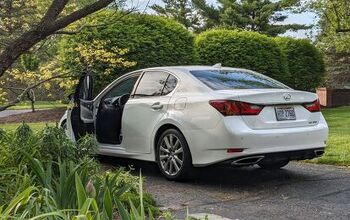A Lesson for Automakers? Navy Abandons Touchscreen Controls Over Safety Concerns

The U.S. Navy has decided to convert the touch screens installed on its destroyer fleet back to mechanical controls after the National Transportation Safety Board (NTSB) cited them in the fatal collision between the USS John S McCain and tanker Alnic MC in 2017. They were also referenced in the collision report released after the USS Fitzgerald collided with the ACX Crystal container ship. While the reports dealt largely with crews being improperly trained on the system’s various functions, the complexity of the graphical interface was cited as a potential issue in itself.
This encouraged Naval Sea Systems Command to conduct fleet surveys in the hope it could get a handle on how officers felt about the systems. The result? Crew members said they wanted more physical controls, echoing the cries of automotive safety advocates the world over.
Despite most average consumers not having a real problem with more tech, numerous automotive studies have shown that typical motorists have grown less knowledgeable on the many features contained within modern-day vehicles. In fact, some brands have gone so far as to implement complementary training sessions for customers hoping to become better informed on how to use newer features. Research also points to current infotainment displays being more mentally demanding and thus less safe to use while driving.
According to USNI News, the Navy’s survey garnered a similar response.
“When we started getting the feedback from the fleet from the Comprehensive Review effort — it was SEA 21 (NAVSEA’s surface ship lifecycle management organization) that kind of took the lead on doing some fleet surveys and whatnot — it was really eye-opening. And it goes into the, in my mind, ‘just because you can doesn’t mean you should’ category. We really made the helm control system, specifically on the [DDG] 51 class, just overly complex, with the touch screens under glass and all this kind of stuff,” Program Executive Officer for Ships Rear Admiral Bill Galinis said explained during the American Society of Naval Engineers’ annual Fleet Maintenance and Modernization Symposium. “So as part of that, we actually stood up an organization within Team Ships to get after bridge commonality.”
In addition to confusing how safety backups function, the navy found touch screen interfaces produced significantly more fatigue among crewmen. Ultimately, sailors confessed to preferring mechanical controls by a wide margin and requested more commonality among ship designs. The Navy said it is already working on accomplishing that goal and will reinstall physical throttles and a traditional helm-control system over the next 18 to 24 months.
Meanwhile, the automotive industry is on the cusp of installing larger touch screens with more functions embedded for drivers to play around with. Unlike the Navy, automakers can utilize vehicular user interfaces to make money via commercial partnerships, automotive apps, and personal data acquisition — so there’s no incentive for them to walk it back.
Unfortunately, touch screens have also been proven to require much higher levels of hand-eye coordination to operate than traditional buttons and dials. Studies suggest that the mere presence of large screens encourage motorists to more frequently take their eyes off the road. While some of this can be mitigated by voice commands, those systems can also be cognitively taxing — especially when ineffective — and most divers still prefer a visual interface. Still, most of the studies producing the damning evidence have been relatively small in scope. It put pressure on major regulatory bodies, but most simply expressed concern without doing much more.
In the United States, the NHTSA has acknowledged distracted driving as a major issue but hasn’t done much to identify problems inherent with modern-day user interfaces. Meanwhile, the UK’s Highways England stated that it didn’t like touch screens in “a safety perspective” issued in 2018, yet failed to provide an alternate solution.
To be fair, there may not be one. At least not one that foregoes a massive overhaul to automotive UX, which could make the industry supremely annoyed after spending so much money developing them. Odds are good that manufacturers will fight any governmental intervention that attempts to streamline the driver interface. Consumers also might be hesitant to embrace legislation that potentially reduces the amount of content available in future vehicles. But, if they Navy’s survey is anything to go by, there’s likely a subset of safety minded drivers out there who would love to see automotive controls go back to basics.
The billion-dollar question, however, is whether or not sacrificing features (and likely new sources of revenue within the industry) is ultimately worth the probable improvements to safety.
[Image: Foxy Burrow/Shutterstock]

A staunch consumer advocate tracking industry trends and regulation. Before joining TTAC, Matt spent a decade working for marketing and research firms based in NYC. Clients included several of the world’s largest automakers, global tire brands, and aftermarket part suppliers. Dissatisfied with the corporate world and resentful of having to wear suits everyday, he pivoted to writing about cars. Since then, that man has become an ardent supporter of the right-to-repair movement, been interviewed on the auto industry by national radio broadcasts, driven more rental cars than anyone ever should, participated in amateur rallying events, and received the requisite minimum training as sanctioned by the SCCA. Handy with a wrench, Matt grew up surrounded by Detroit auto workers and managed to get a pizza delivery job before he was legally eligible. He later found himself driving box trucks through Manhattan, guaranteeing future sympathy for actual truckers. He continues to conduct research pertaining to the automotive sector as an independent contractor and has since moved back to his native Michigan, closer to where the cars are born. A contrarian, Matt claims to prefer understeer — stating that front and all-wheel drive vehicles cater best to his driving style.
More by Matt Posky
Latest Car Reviews
Read moreLatest Product Reviews
Read moreRecent Comments
- Merc190 I would say Civic Si all the way if it still revved to 8300 rpm with no turbo. But nowadays I would pick the Corolla because I think they have a more clear idea on their respective models identity and mission. I also believe Toyota has a higher standard for quality.
- Dave Holzman I think we're mixing up a few things here. I won't swear to it, but I'd be damned surprised if they were putting fire retardant in the seats of any cars from the '50s, or even the '60s. I can't quite conjure up the new car smell of the '57 Chevy my parents bought on October 17th of that year... but I could do so--vividly--until the last five years or so. I loved that scent, and when I smelled it, I could see the snow on Hollis Street in Cambridge Mass, as one or the other parent got ready to drive me to nursery school, and I could remember staring up at the sky on Christmas Eve, 1957, wondering if I might see Santa Claus flying overhead in his sleigh. No, I don't think the fire retardant on the foam in the seats of 21st (and maybe late 20th) century cars has anything to do with new car smell. (That doesn't mean new car small lacked toxicity--it probably had some.)
- ToolGuy Is this a website or a podcast with homework? You want me to answer the QOTD before I listen to the podcast? Last time I worked on one of our vehicles (2010 RAV4 2.5L L4) was this past week -- replaced the right front passenger window regulator (only problem turned out to be two loose screws, but went ahead and installed the new part), replaced a bulb in the dash, finally ordered new upper dash finishers (non-OEM) because I cracked one of them ~2 years ago.Looked at the mileage (157K) and scratched my head and proactively ordered plugs, coils, PCV valve, air filter and a spare oil filter, plus a new oil filter housing (for the weirdo cartridge-type filter). Those might go in tomorrow. Is this interesting to you? It ain't that interesting to me. 😉The more intriguing part to me, is I have noticed some 'blowby' (but is it) when the oil filler cap is removed which I don't think was there before. But of course I'm old and forgetful. Is it worth doing a compression test? Leakdown test? Perhaps if a guy were already replacing the plugs...
- Crown No surprise there. The toxic chemical stew of outgassing.
- Spamvw Seeing the gear indicator made me wonder when PRNDL was mandated.Anyone?Anyone?1971


































Comments
Join the conversation
I wish the center stack in modern cars was literally an empty rack, like a mini version of old rack stereo systems in homes. The car would come with just the essential electronics (ignition timing, fuel injector timing, etc). All the modern electronics and screen(s) would be rack-mounted modules in the center stack that could be switched out, just like old radios. That way, you could have the interface that you preferred (touch screen, knobs, or some combination thereof). It seems a shame that we have the heavy metal (chassis, engine, transmission), that can last well over a decade, married to the electronics (GPS, radio, etc) that become anachronistic in a few short years.
If you want to really get scared about touchscreen systems on naval platforms, go dig into the Operating Systems they run. Respect the classics lol.